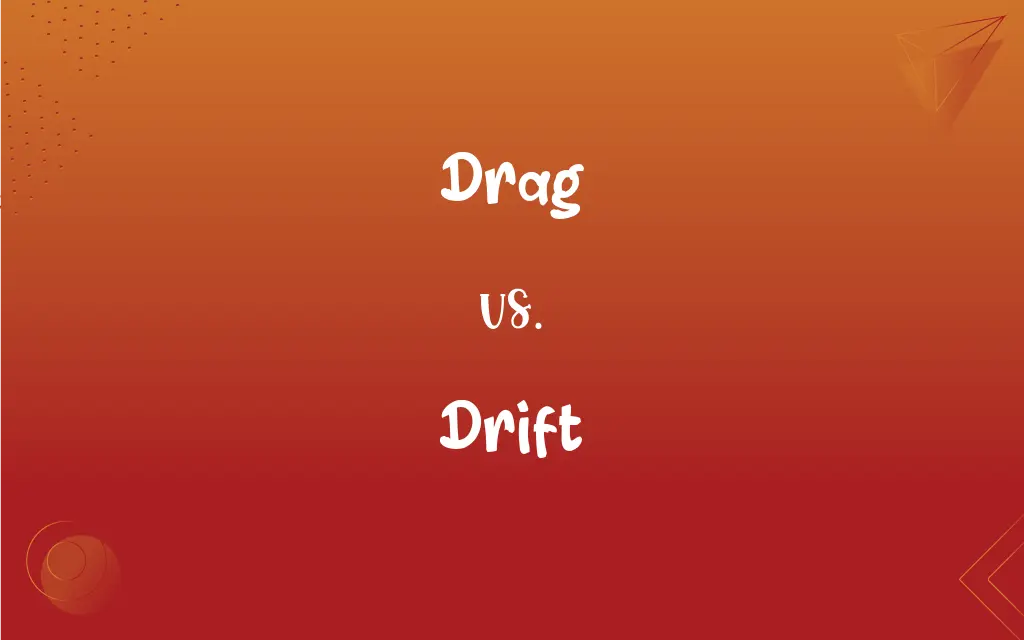Drag vs. Drift: What's the Difference?
Edited by Janet White || By Harlon Moss || Updated on November 3, 2023
Drag refers to resistance or the act of pulling with force, whereas drift denotes a gradual movement or change from an original course or position.

Key Differences
Drag is a term often used in physics to describe a force that opposes an object's motion through a fluid like air or water. This force is a result of the object's shape, speed, and the fluid's characteristics, and is critical in designing vehicles for efficiency. Drift, on the other hand, signifies a slow and gradual movement or change in position, typically caused by external forces or currents, without the intent of the object moving. It's a term frequently associated with sideways movement in vehicles, but can also apply to shifts in opinion, policy, or conditions over time.
In the context of driving, drag can impact the vehicle's fuel efficiency and speed, as higher drag forces require more energy to maintain speed. Drift in driving usually refers to a car moving laterally due to loss of traction, an intentional maneuver in motorsports, or a gradual change in trajectory due to road conditions. Both are concerned with motion, but drag is an opposing force, while drift is a type of motion.
In aeronautics, drag is a critical component in flight dynamics, affecting how much thrust an aircraft needs to overcome air resistance. Drift in aviation might refer to a deviation from a set course due to wind conditions, requiring adjustments to maintain the intended path. Both concepts are crucial for flight planning and aircraft design.
Regarding watercraft, drag is a force that must be overcome to achieve and maintain speed. Drift can occur due to currents, causing the vessel to move from its intended course. Both need to be considered by navigators to ensure accurate and efficient travel.
In terms of social phenomena, drag and drift also have metaphorical applications. Drag can signify resistance to change or progress within a group or society. Drift may refer to the gradual shift in cultural norms or attitudes over time, often without deliberate direction or control. Both reflect the tension between active resistance and passive change within social dynamics.
ADVERTISEMENT
Comparison Chart
Definition
Resistance against motion
Gradual change of course or position
In Physics
Force opposing motion in fluid
Slow movement due to external forces
In Vehicles
Decreases efficiency, requires more energy
Lateral movement, loss of traction
In Navigation
Must be overcome for movement
Movement caused by currents
Metaphorical Use
Resistance to change
Gradual shift in norms or attitudes
ADVERTISEMENT
In Watercraft
Resistance through water
Off-course movement due to currents
In Social Context
Impeding progress
Gradual societal or cultural change
Drag and Drift Definitions
Drag
The aerodynamic force opposing an object's motion through air or water.
Engineers work to reduce a car's drag to improve fuel efficiency.
Drift
A gradual shift from one state or condition to another.
There's been a drift away from traditional practices.
Drag
To pull something with effort or difficulty.
They had to drag the couch up three flights of stairs.
Drift
To accumulate in piles by the action of wind or water.
Snow began to drift against the fence.
Drag
To act as a hindrance or impediment.
His lack of experience began to drag the project down.
Drift
To be carried slowly by a current of air or water.
The boat began to drift out to sea.
Drag
To prolong an event or activity unnecessarily.
The meeting dragged on for hours.
Drift
To walk aimlessly or without a specific goal.
He liked to drift through the city streets at night.
Drag
To force someone to go somewhere they do not wish to.
She had to drag her kids away from the playground.
Drift
The meaning to which something indirect or vague is tending.
I caught the drift of his argument.
Drag
To pull along with difficulty or effort; haul
Dragged the heavy box out of the way.
Drift
To be carried along by currents of air or water
A balloon drifting eastward.
As the wreckage drifted toward shore.
Drag
To cause to trail along a surface, especially the ground
Don't drag your coat in the mud.
FAQs
Can drag also mean something non-physical?
Yes, drag can also mean something that hinders progress or an event that's drawn out.
What does drag typically refer to in physics?
In physics, drag refers to the force that opposes an object's movement through a fluid.
Does drift always involve physical movement?
No, drift can also refer to a gradual change in opinion or circumstances.
What might cause a vehicle to drift?
A vehicle might drift due to loss of traction or intentional steering maneuvers.
Are drag and drift only relevant to vehicles?
No, drag and drift can apply to many areas, including physics, navigation, and social contexts.
How does drag influence airplane design?
Airplanes are designed to minimize drag for better fuel efficiency and performance.
Can drag affect the energy efficiency of a vehicle?
Yes, increased drag forces can reduce a vehicle’s energy efficiency.
Is drift always unintentional?
No, drift can be both intentional, as in motorsports, or unintentional, as with currents.
Can drift be used as a noun and a verb?
Yes, drift can be used to describe both the action of moving slowly (verb) and the phenomenon itself (noun).
What is drift in the context of motion?
Drift is the slow, gradual movement of an object, often due to external forces.
Can weather conditions cause drift?
Yes, weather conditions like wind or currents can cause an object or vehicle to drift.
How do navigators compensate for drift?
Navigators adjust their course to compensate for drift caused by currents or wind.
How does drag affect ships?
Drag affects ships by creating resistance in water, impacting speed and fuel consumption.
What does drift mean in a social context?
In social terms, drift refers to the slow shift in societal norms or cultural attitudes.
Can drag be beneficial in any context?
Drag is beneficial in braking systems and parachutes where resistance is desired.
Does drag always increase with speed?
Generally, drag increases with the square of speed, especially in fluids like air and water.
Is drift related to stability in vehicles?
Yes, excessive drift in vehicles can indicate a lack of stability and control.
Can drift be controlled in driving?
Yes, skilled drivers can control drift in driving, commonly seen in motorsports.
Can drag be used as a verb?
Yes, drag can describe the act of pulling something with difficulty.
Do drag and drift have positive or negative connotations?
Context matters, but drag often has a negative connotation as resistance, while drift can be neutral or negative.
About Author
Written by
Harlon MossHarlon is a seasoned quality moderator and accomplished content writer for Difference Wiki. An alumnus of the prestigious University of California, he earned his degree in Computer Science. Leveraging his academic background, Harlon brings a meticulous and informed perspective to his work, ensuring content accuracy and excellence.
Edited by
Janet WhiteJanet White has been an esteemed writer and blogger for Difference Wiki. Holding a Master's degree in Science and Medical Journalism from the prestigious Boston University, she has consistently demonstrated her expertise and passion for her field. When she's not immersed in her work, Janet relishes her time exercising, delving into a good book, and cherishing moments with friends and family.































































